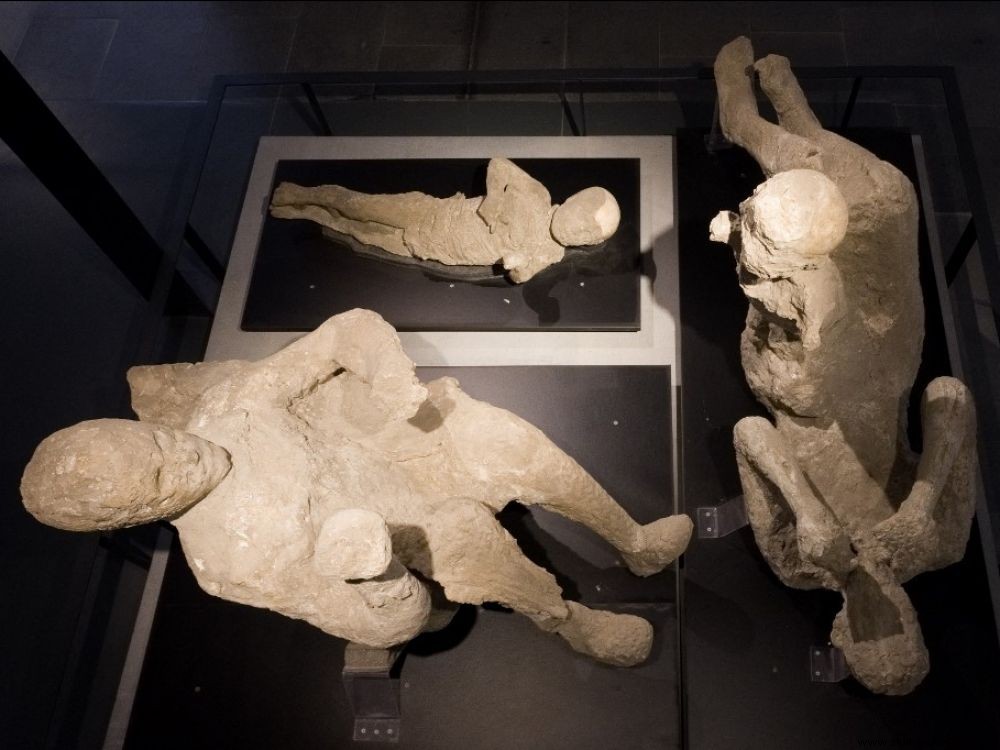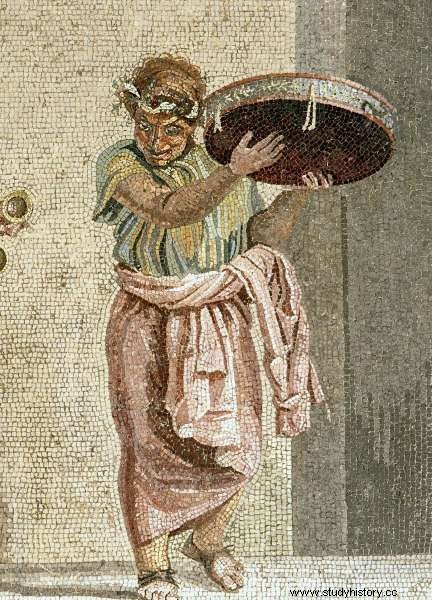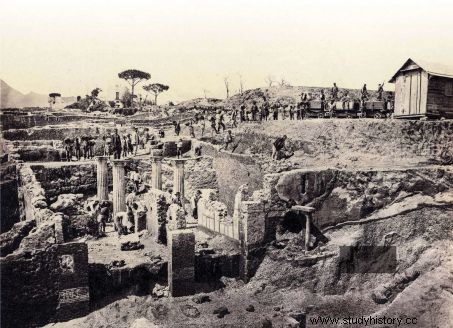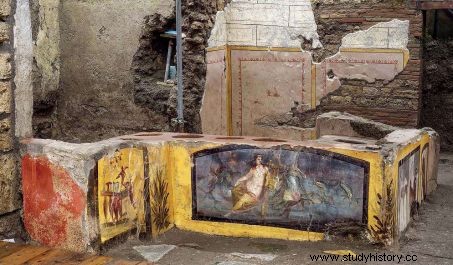A block of marble found during the digging of a well, and this is the start of a treasure hunt... Before the first archaeological site in history resuscitates Pompeii the sumptuous, forgotten for centuries.

Casts of a man with a baby, an adult and another baby on display at the Antiquarium museum at the archaeological site of Pompeii on January 25, 2021.
This article is from the magazine Sciences et Avenir - Les Indispensables n°206, dated July/September 2021.
"Will future centuries be able to believe, when the harvests grow again and these deserts finally become green again, that cities and populations are swallowed up under their feet and that the countryside of their ancestors has disappeared under a sea of fire? " , wondered the Latin poet Stace, about fifteen years after the eruption of Vesuvius which, in 79, froze Pompeii under the lapilli and the ashes. He never imagined that the city of Campania, brutally erased from the map, disappeared from memory, would not reappear until… seventeen centuries later, giving birth to the first major archaeological site in history. Without the plowing of local peasants exhuming its vestiges, without the ambition of the crowned heads of the century eager for antiquities, Pompeii could have remained buried for a few hundred years longer. Its very name had been lost. So much so that in 1592, when the architect Domenico Fontana built a canal to bring water from the Sarno river to the coastal town of Torre Annunziata, he dug next to the city's amphitheater without even noticing it!
And the discovery of an inscription mentioning a decurion from Pompeii provokes no reaction. "Incredible, when you think about it! is still surprised William Van Andringa, director of studies at the Practical School of Advanced Studies, who has been excavating the necropolises of Pompeii for twenty years. It is the name of Pompey that comes to mind when engineers discover the inscription! Think that this channel crosses the ancient city. The science of identifying remains has not yet been born." The greenery regains its rights, only the name of the hill, Civita, evokes the city.
In 1748, the engineer Alcubierre removed paintings and mosaics… then backfilled!
This article is from the magazine Sciences et Avenir - Les Indispensables n°206, dated July/September 2021.
"Will future centuries be able to believe, when the harvests grow again and these deserts finally become green again, that cities and populations are swallowed up under their feet and that the countryside of their ancestors has disappeared under a sea of fire? " , wondered the Latin poet Stace, about fifteen years after the eruption of Vesuvius which, in 79, froze Pompeii under the lapilli and the ashes. He never imagined that the city of Campania, brutally erased from the map, disappeared from memory, would not reappear until… seventeen centuries later, giving birth to the first major archaeological site in history. Without the plowing of local peasants exhuming its vestiges, without the ambition of the crowned heads of the century eager for antiquities, Pompeii could have remained buried for a few hundred years longer. Its very name had been lost. So much so that in 1592, when the architect Domenico Fontana built a canal to bring water from the Sarno river to the coastal town of Torre Annunziata, he dug next to the city's amphitheater without even noticing it!
And the discovery of an inscription mentioning a decurion from Pompeii provokes no reaction. "Incredible, when you think about it! is still surprised William Van Andringa, director of studies at the Practical School of Advanced Studies, who has been excavating the necropolises of Pompeii for twenty years. It is the name of Pompey that comes to mind when engineers discover the inscription! Think that this channel crosses the ancient city. The science of identifying remains has not yet been born." The greenery regains its rights, only the name of the hill, Civita, evokes the city.
In 1748, the engineer Alcubierre removed paintings and mosaics… then backfilled!
The second life of Pompeii will begin by chance thanks to Herculaneum, the neighboring city also buried by the volcano. And to the Duke of Elbeuf who, in 1710, in search of materials to build a villa at Portici, in the Bay of Naples, bought from a peasant some marble found during the digging of a well. Understanding that the stone comes from Roman antiquities, the aristocrat buys back his land from the villager; he quickly brought to light a statue of Hercules and three others of women, intact, which he sent to Vienna. The news spread and ended up attracting the attention of Charles de Bourbon (1716-1788), then King of Naples and Sicily… and fond of antiques. He acquires the villa of Portici, relaunches the search. It will turn out that the peasant's well was located just above the theater of Herculaneum… a city which will be discovered in 1738.
"The excavations of Pompeii would not have taken place without those of Herculaneum, explains Sandra Zanella, lecturer in ancient history and archeology at the University of the Côte d'Azur. There is an element of luck in the rediscovery of the cities of Campania, even if all the inhabitants were aware that important remains were there." For the time being, we are not talking about excavations, let alone archeology. The sovereign, who wants to decorate his palace and establish his prestige, rather embarks on a treasure hunt, recovering jewels, frescoes, columns... Precious vestiges which Civita also abounds in. It will nevertheless be necessary to wait ten years so that, on March 13, 1748, Alcubierre, a surveying engineer commissioned by the king, opens a first site on this hill. He understands that he is uncovering a city but believes that it is Stabies, located in reality further south. The engineer uses a mining type method, first digging a shaft and then a network of galleries. He unearths tables, chests, bronze candelabra, remains of beds, marble columns, copings, wells... He recovers sections of walls with their paintings, removes the mosaics... then backfills! The work hardly differs from that of the looters who had raged the day after the eruption… Alcubierre was sharply criticized by the scholars who made the trip to Naples. The German Johann Joachim Winckelmann (1717-1768), a great specialist in ancient art, considered a pioneer of archeology because, through his letters, he revealed Pompeii to Europe, describes him as a man with "as little to do with antiquities as the moon has with crayfish". He accuses her of having "caused by her lack of abilities the loss of beautiful things" and is also surprised at the softness of the work distributed to "only fifty men, even counting the slaves of Algiers and Tunis" .
Over the years, however, Pompeii will steal the show from its neighbors:the lapilli that covered the site are much lighter, and the work is easier there. But the name was not clearly identified until 1763, when workers unearthed a marble bearing the inscription res publicapompianorum . That year, the authorities instructed masons and blacksmiths to restore the ruins. Buildings are left in the open. And the spectacular discoveries follow one another:the Odeon in 1764, the temple of Isis a few months later, the first eighteen bodies in 1772, in the villa of Diomede… We owe the two assistants of Alcubierre the preservation of these early remains. One of them, Francesco La Vega, an engineering officer trained in Rome, "brings in Neapolitan painters who copy the paintings, reproduce the mosaics. He positions and describes all the objects" , explains Hélène Dessales, lecturer at the École Normale Supérieure, specialist in Pompeii. Highly cultured, he read treatises in Latin and maintained ties with the intellectuals of the time. "Studies of excavation reports lead us today to qualify the idea of blind research and looting that have long been associated with this period, continues the researcher . We discover that there is then, and for the first time, a heritage awareness."
Until 1810, Pompeii nevertheless remained the reserved domain of the sovereigns, who only issued visit permits to prestigious travelers and imposed secrecy:it was forbidden to take notes or draw there! Mozart visited Pompeii in 1770 with his father, raved about the temple of Isis, which inspired him to compose The Magic Flute , Théophile Gautier takes the villa of Diomede as the setting for one of his short stories. But some visitors, accustomed to large monuments, are disappointed. In 1777, Vivant Denon, future director of the Louvre Museum, spoke of houses "made for dwarfs"; ten years later, Goethe evokes "doll houses" . With the advent of the romantic movement, the city seized by death inspired writers:Chateaubriand in 1804, Mme de Staël the following year, or even Stendhal in 1817.

Bullet musician. This mosaic comes from the villa of Cicero, one of the first vestiges exhumed in the 18th century.
No longer finding ancient objects, but knowing the past
During the occupation of the Kingdom of Naples by the French, from 1806 to 1815, Caroline Murat, Napoleon's sister, invested considerable sums in the site, which she visited regularly and where there were up to 1,000 workers. each day. A town appears. The goal is no longer to find ancient objects, but to know the past. "This French interlude marks the first urban excavation site, says Hélène Dessales. With the desire to clear an entire city over an area of more than 60 hectares. Caroline asked the architect François Mazois to survey the entire site:he published four reference volumes." The return to power of the Bourbons broke this momentum. The sovereigns are less interested in Pompeii. But in 1860, Garibaldi, architect of Italian unity, entered Naples and chased them from power. He offers the direction of the excavations to… his friend the novelist Alexandre Dumas, whose mandate will only be ephemeral. With the unification of the Kingdom of Italy in 1861, practices became more professional:the new superintendent of Pompeii, archaeologist Giuseppe Fiorelli, divided the site into nine regions, conducted excavations by district, protected the frescoes he left in situ . He applies the stratigraphic method, borrowed from geology and already used on prehistoric sites. He clears the houses through the roof, digging downwards. Fiorelli is also the inventor of a technique that marks the spirits:he injects plaster into the cavities formed by the bodies of the victims caught in the eruptive gangue. These casts restore the attitude of the Pompeians when death seized them. The famous brothel was reborn from the ashes in 1862. A few decades later, rue de l'Abondance was cleared for 600 meters, revealing an entire section of the urban landscape with its facades, multi-storey buildings, shops... From 1925, Superintendant Maiuri researches the archaic levels of the city to understand its pre-Roman past. He also endeavors to restore this commercial city of about 10,000 inhabitants, known for the crafts of wool and for its perfumeries, to the time of the eruption.

Well-ordered site. From the 1860s (here around 1870), the site will be methodically studied according to the principles of stratigraphy:the layers of human occupation are unearthed one after the other in order to establish their chronology. Credit:ALINARI/ROBERT RIVE/ROGER-VIOLLET
Since then, interest in Pompeii has never wavered. "It is one of the most drawn and photographed sites in the world, which also allows us to follow the history of excavations and that of tourism, because it was first reserved for a privileged few before becoming a paying archaeological park, observes Hélène Dessales. This project has contributed enormously to the knowledge of Roman town planning, with however a risky interpretation effect :other Roman sites are still read through its prism today. But Pompeii is an extraordinary city, in particular because it was under reconstruction at the time of the disaster :about a third of it had been demolished by an earthquake less than twenty years before. Buildings like the villa of Diomede were no longer even inhabited. And some objects are sometimes unrelated to the room where they rest :they were stored pending work."
The "lovers" entwined:two men, according to DNA analysis of their skeletons
"It is not enough to remove the pumice stones spewed by Vesuvius to understand how people lived , approves Nicolas Monteix, lecturer at the University of Rouen. Pompeii has skewed our vision and produced many fantasies, in particular that of a frozen city, like in a photograph. In fact, the situations observed during the excavations were strongly disturbed before, during and after the eruption." Certain examples testify well to these possible errors:thus, the two entwined skeletons called "the lovers", a man and a woman in everyone's mind. DNA analysis revealed that they were two men, possibly two neighbors, two friends… or lovers. There are secrets that Pompeii will keep for eternity.

Roman bistro. This fast food counter, or thermopolium, was discovered in December 2020 in an exceptional state of preservation. Wine and hot dishes were served there, the remains of which archaeologists have found:duck, pork, goat, fish and even snails. Credit:LUIGI SPINA/ PRESS OFFICE OF THE POMPEI ARCHAEOLOGICAL PARK/ AFP
A third of the site remains to be excavated
A thermopolium , fast food from Antiquity, two individuals surprised in their flight by the eruption, a fresco representing Leda, a character from Greek mythology, a mosaic of Orion... The announcements of discoveries have been linked since 2018 in Pompeii, which approached 4 million visitors a year before the pandemic. Because, for the first time since the Second World War, excavations are exploring a sector still buried so far, Regio V. Of the 66 hectares that Pompeii covers, 22 have never been excavated. This new project is part of the Great Pompeii Project. Funded by the Italian government and Europe, and initially intended to consolidate and restore the buildings already unearthed, it benefits from state-of-the-art techniques. Archaeologists, engineers and architects use laser mapping produced from drones as well as infrared thermography to position each house or object, and to reconstruct buildings in 3D. An international team led by Hélène Dessales carried out the project dedicated to the villa of Diomede, one of the first aristocratic residences in Pompeii to have been exhumed. The house can now be visited interactively in 3D. These new methods make it possible to revisit certain conclusions established in previous centuries. A man nicknamed the Beggar was actually wearing expensive shoes, examination of the leather showing it to be of excellent quality. And when scanned, Fiorelli's casts reveal from the condition of the skull and bones that many of the victims perished not by suffocation, but crushed by the collapse of their homes.
